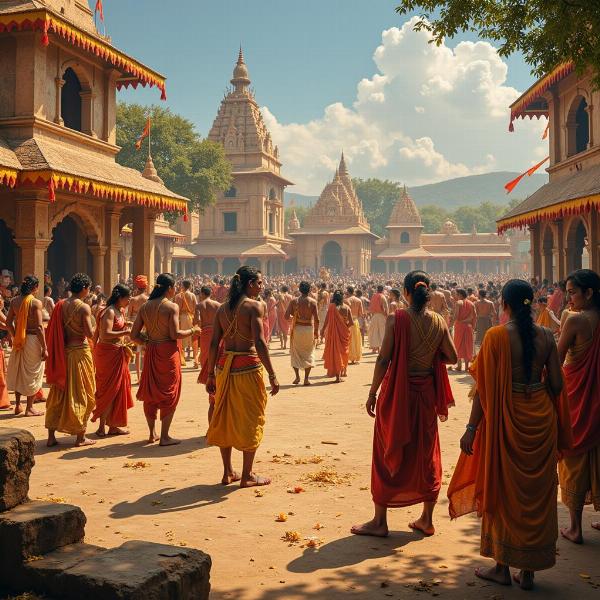Understanding the true meaning of “parv” in Hindi goes beyond a simple dictionary definition. It delves into the rich cultural and religious tapestry of India, where festivals and celebrations hold immense significance. “Parv” (पर्व) primarily translates to “festival” or “occasion,” but its connotations extend far beyond mere festivities. It embodies the spirit of tradition, togetherness, and spiritual devotion that permeates Indian society. The word evokes images of vibrant colors, joyous music, and the aroma of traditional delicacies, creating a sensory experience that resonates deeply with the Indian soul.
Exploring the Nuances of “Parv”
“Parv” encompasses a wide spectrum of celebrations, from religious festivals like Diwali and Holi to social and cultural occasions like weddings and birthdays. Each “parv” carries its own unique significance and rituals, reflecting the diverse traditions and beliefs prevalent in India. The word often implies a sense of auspiciousness and reverence, marking a special time for reflection, renewal, and connection with the divine. What is the Hindi meaning of “parv” in the context of religious practices? It often refers to a sacred day observed with fasting, prayers, and special rituals, aimed at seeking blessings and spiritual purification.
“Parv” also plays a vital role in strengthening social bonds. These occasions provide opportunities for families and communities to come together, share meals, exchange gifts, and participate in traditional activities, fostering a sense of unity and belonging. The collective celebration of “parvs” reinforces shared values and strengthens the fabric of Indian society.
Parv in Literature and Culture
The concept of “parv” is deeply ingrained in Indian literature and culture. Ancient epics like the Mahabharata and Ramayana are replete with descriptions of grand festivals and celebrations, showcasing their importance in ancient Indian life. These narratives often portray “parvs” as occasions for divine intervention, heroic deeds, and the unfolding of significant events. The word “parv” itself is derived from Sanskrit, further emphasizing its historical and cultural roots.
 Parv in Indian Literature
Parv in Indian Literature
The Significance of “Parv” in Modern India
Even in contemporary India, “parvs” continue to hold a prominent place in people’s lives. While some of the rituals and traditions may have evolved over time, the core values of togetherness, spirituality, and cultural preservation remain strong. “Parvs” offer a much-needed respite from the fast-paced modern world, providing an opportunity to reconnect with one’s roots and celebrate the rich heritage of India.
Parv vs. Tyohar: Is There a Difference?
While both “parv” and “tyohar” (त्योहार) are used to refer to festivals in Hindi, there is a subtle distinction between the two. “Tyohar” generally refers to any festive occasion, while “parv” carries a more formal and traditional connotation, often associated with religious or culturally significant celebrations. However, in common usage, the two terms are often used interchangeably. parvesh meaning in hindi
Conclusion: The Enduring Spirit of “Parv”
The meaning of “parv” in Hindi transcends a simple translation. It represents the heart and soul of Indian culture, embodying the values of tradition, spirituality, and community. From the grand religious festivals to the intimate family gatherings, “parv” continues to play a vital role in shaping the social and cultural landscape of India, enriching the lives of millions with its vibrant tapestry of colors, music, and traditions. Understanding “parv” is crucial to appreciating the true essence of Indian culture. parvat meaning in hindi
FAQ
- What is the literal meaning of “parv” in Hindi? “Parv” literally translates to “festival,” “occasion,” or “node.”
- What are some examples of “parv” celebrated in India? Diwali, Holi, Dussehra, Eid, Christmas, and Guru Nanak Jayanti are just a few examples.
- Why are “parvs” important in Indian culture? They reinforce social bonds, preserve cultural heritage, and provide opportunities for spiritual reflection.
- Is there a difference between “parv” and “tyohar”? While both refer to festivals, “parv” often carries a more formal and traditional connotation.
- How are “parvs” celebrated in modern India? While some traditions may have evolved, the core values of togetherness, spirituality, and cultural preservation remain strong. what is the hindi meaning of expedition
Meaning-Hindi.in is your one-stop solution for all your Hindi translation needs. We offer a wide range of professional translation services, including business and commercial document translation, certified and legal document translation, technical and user manual translation, website and localization services, and academic translation. Need a quick turnaround? We also provide express translation services. himadri meaning in hindi hindi meaning of ridge Our expertise spans various specialized fields, ensuring accurate and culturally sensitive translations. Contact us today at [email protected] or call us at +91 11-4502-7584. Meaning-Hindi.in is your trusted partner for bridging language barriers.